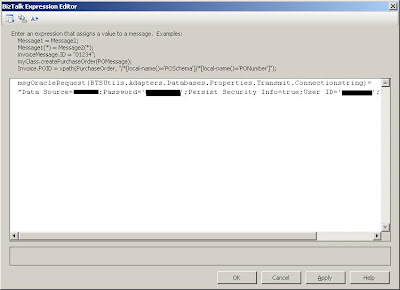BizTalk supports messaging patterns that provide the ability to wait for messages to arrive before completing a business process(or orchestration). These mechanisms tend to use correlation and the use of convoys. Stephen W Thomas has written a whitepaper that dives into these topics further.
Solution
 The second artifact represents data that could be generated by an upstream system such as SAP or a Mainframe. This document is entirely fictitious so don't look too much into it. Also note that I have a promoted property called FileName that is used in my Correlation Type.
The second artifact represents data that could be generated by an upstream system such as SAP or a Mainframe. This document is entirely fictitious so don't look too much into it. Also note that I have a promoted property called FileName that is used in my Correlation Type.
 Below is a snapshot of what our orchestration looks like.
Below is a snapshot of what our orchestration looks like. A few things to note is that Non-Uniform Sequential convoys to require that both receive shapes connect to the same receive port. This logical receive port also needs to be marked for Ordered Delivery.
A few things to note is that Non-Uniform Sequential convoys to require that both receive shapes connect to the same receive port. This logical receive port also needs to be marked for Ordered Delivery.
For the initial receive shape we need to set a few properties. Since this is the first Receive shape we need to set the Activate property to True in order to instantiate the orchestration.
The other property that we need to populate is the Initializing Correlation Sets. In order for BizTalk to "wait" for the work file to be picked up by the same instance of the orchestration that consumed the signal file we need to initialize a correlation set. (Keep reading for more info on how to create the Correlation Set).
 Prior to creating a Correlation Set, you need to create a Correlation Type. You can do this from the Orchestration View tab.
Prior to creating a Correlation Set, you need to create a Correlation Type. You can do this from the Orchestration View tab. 

 In the Rename Work File Expression shape we are going to call a .Net Helper class that will aid in renaming work file in the source folder. This step is a critical step in the process. Since the work file is completely written before the sig file is, we cannot use the original file extension in the Receive Location file mask. Otherwise, this would prompt BizTalk to consume the work file prior to us wanting it to be consumed. By appending a temporary extension, like .BIZ, to the end of the work file name, we can be assured that BizTalk will pick the file up when we want it to. So in the Receive Location we will use a *.BIZ extension instead of a *.XML.
In the Rename Work File Expression shape we are going to call a .Net Helper class that will aid in renaming work file in the source folder. This step is a critical step in the process. Since the work file is completely written before the sig file is, we cannot use the original file extension in the Receive Location file mask. Otherwise, this would prompt BizTalk to consume the work file prior to us wanting it to be consumed. By appending a temporary extension, like .BIZ, to the end of the work file name, we can be assured that BizTalk will pick the file up when we want it to. So in the Receive Location we will use a *.BIZ extension instead of a *.XML.Note that I have hard coded the path of the source location. Since this is a POC, this is ok but this would not be a suitable solution for a production environment

In order for BizTalk to "wait" for the work file to be picked up, we need to set the Following Correlation Sets property with the same Correlation Set that we initialized in the first Receive shape. Since the rename operation occurs the step before, the "wait" time will be extremely small. The main point here is that we want to control when BizTalk picks up the work file. It is essentially the rename operation and the second receive shape/location that controls this.
 Now that you have consumed both the signal file and work file, in order, you can finish up any processing that is required by your business requirements. Since this is just a POC, I output the work file to a folder.
Now that you have consumed both the signal file and work file, in order, you can finish up any processing that is required by your business requirements. Since this is just a POC, I output the work file to a folder.Testing
In order to simulate how an upstream system would write the files, I drop a file into the work folder with the original extension. I then drop a sig file into the sig folder. The sig file will get picked up and BizTalk, via the .Net Helper, will rename the work file. The receive location, for work files, will then pick up the work file and the orchestration will finish processing both files.
Conclusion
Through the use of a Messaging Pattern and with the help of a .Net Helper class we can process a set of files in a known order.





